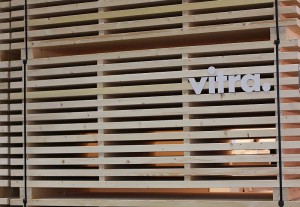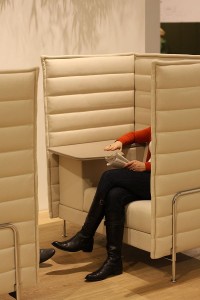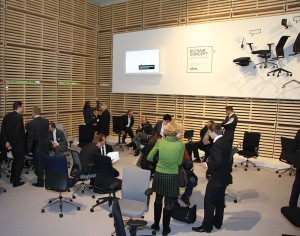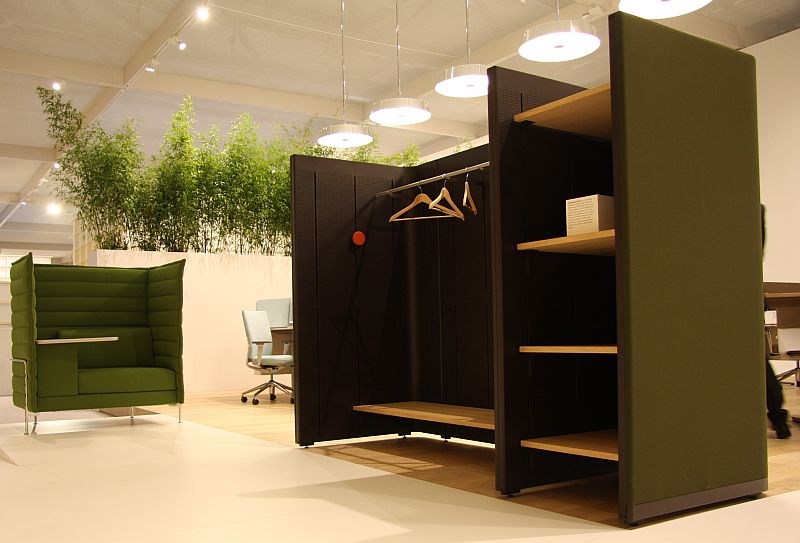
Although the public face of Vitra is unquestionably their "Home Collection", for decades the backbone of the company has been their office furniture division.
Consequently a central feature of Vitra's daily work involves developing new approaches to office design and attempting to predict what will be important for office workers in the coming years.
In 1991 Vitra commissioned the designers Michele de Lucchi, Ettore Sottsass and Andrea Branzi to develop some plans for future office design. A central component was the creation of an office environment that was both social and productive.
Since then Vitra have developed numerous variations on the theme. At Orgatec 2008, for example, Vitra presented their Net'n'Nest office design concept - a concept that essentially split an open plan office into spaces for communicative, group work (Net') and spaces for concentrated, individual work ('Nest) and provided furniture for both situations.
At Orgatec 2010 Vitra's catchword was "Citizen Office 2011" .
Taking stock as it were 20 years after Branzi, de Lucchi and Sottsass presented the results of their research, Vitra's "Citizen Office 2011" aims to present an up-to-date version of that work in the context of modern work practices, and in many ways can also be seen as further development of Net'n'Nest.
Sadly, Vitra felt obliged to riddle the whole exercise with the sort of unnecessary marketing vocabulary that makes our blood boil.
That marketing professionals have their own linguistic register is not only known but has been the subject of office satire for decades - we played our first game of "Marketing Jargon Bingo" in 1993 - and we're certain that the average Vitra commercial customer is not only aware of this but is intelligent enough to get the idea on their own.
No one has ever sold anything by giving a collection of desks a marketing name and then comparing them to a suburban district.
And they never will.
Ever.
And to attempt such is a waste of time and money.
Always.

Fortuitously one or the other product presented by Vitra at Orgatec 2010 was of such a quality that it could calm our pulsating veins.
It sounds obvious but we were genuinely impressed with the Alcove Work by Ronan and Erwan Bouroullec. The Alcove is one of our favourite sofa designs, but was for us never an option for the office; however, by simply adding some storage space and a small surface on which one can write, the Bouroullecs have transformed it into something that can genuinely be recommended for workspaces.
The Bouroullec's Communal Cells, in contrast, initially made us recoil in horror - because we couldn't understand why either Vitra or the Bouroullecs would want to produce a modern version 1970s airport telephone cells.
Then we realised that Communal Cells is in effect a modular concept with which users can create their own interior architecture.
And as with all sensible systems - rebuild and reconstruct as and when required.
And so with Communal Cells you have the possibility to create space for printers/copiers, for holding impromptu meetings, for installing a "snooze corner"... or whatever your office needs.
And once we understood that, we were genuinely impressed with the concept.

The other dominant designer within Vitra's Orgatec 2010 show was Antonio Citterio. In addition to the Suita Club Sofa / Armchair and Unix Chair Citterio's most important contribution was without question the new ID Chair Concept.
Centred around a new patented motion system the ID Chair Concept looks like it will be a central feature of Vitra's office design concepts for the next few years.
But more on the ID Chair Concept in a separate post.
In addition Vitra presented new products from Naoto Fukasawa, Arik Levy and the aforementioned HAL by Jasper Morrison.
Despite the marketing folks best attempts to muddy the waters, Vitra still base a lot of their office design concepts on a loose interpretaton of Charles Eames "Collage" approach to domestic furnishing - which is no bad thing and certainly nothing to be ashamed of.
Variety is not only the spice of life but a necessity in an effective work place.
And so whereas "Citizens Office 2011" wont change the way companies and individuals think about their office environments - we're certain that many of the individual products launched at Orgatec 2010 will.
And that many of the resulting office designs will ultimately resemble what Vitra discuss in their "Citizen Office 2011" manifesto.
Just without superfluous Office Forums and Workstation Areas.
